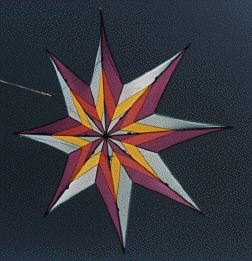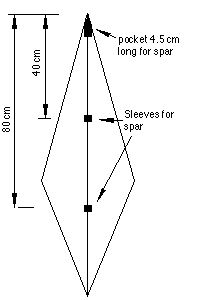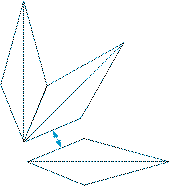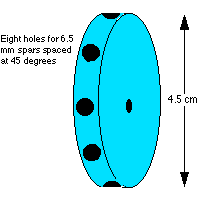 Eight Point Star Kite Plan
Eight Point Star Kite Plan

| Here's a flat kite that is a bit different and likes medium to strong winds. Despite its appearance of complexity it is quite quick and easy to build.
 One has been built by Rene Kempen from Holland. Rene has used 6mm EXEL carbon fibre (RCF-6) spars and the fabric is Carrington K-42. One has been built by Rene Kempen from Holland. Rene has used 6mm EXEL carbon fibre (RCF-6) spars and the fabric is Carrington K-42.
Cut out sixteen segments, eight left hand ones and eight right hand segments with the fabric grain oriented as shown on the diagram. Its a good idea to make a template for these segments to ensure they are all the same. (Only one template is needed as it can be flipped over for the opposite side) Note the dimensions shown are the finished dimensions and 1 cm should be allowed all round for seams and hem. Print this template out to work from.
|  |
Hem the one edge as shown. Sew the LHS and RHS segments together in pairs to make eight separate point segments for the star as in fig 1.
Add a pocket 45 cm long to take a 6.5 mm spar from 4 oz Dacron to the tip. Add two loops of ripstop to the centre seam line as sleeves for the spar. These need to only be about 2 cm long. |
 |

Start joining the segments together along the shorter side. The centre lines of each segment should be at an angle of 45 degrees. I made a cardboard setsquare to aid in keeping this accurate. All the segments should be taped or hot tacked together before starting final sewing to ensure that the diagonally opposite points are perfectly in line.
The kite is spared with 6.5 mm tubular glass fibre spars fitted with end caps at the tips and a central eight-way connector. My connector came from the store of the "Kiteman" (Mark Olivier) in Melbourne but it could be fabricated. It is a 45 mm disk drilled at eight spots around the edge 45 degs apart to take the 6.5 mm spars. Another hole is drilled through the centre for the bridle.
 To get the correct length for the spars I used two dowel lengths 2 metres long and put them through tip to tip at right angles. I then trimmed them to make sure that they were both the same length and not too much stretch was on the fabric. From these I worked out the spar length less the thickness of the central connector. My spars finished up being 98 cms long.
To get the correct length for the spars I used two dowel lengths 2 metres long and put them through tip to tip at right angles. I then trimmed them to make sure that they were both the same length and not too much stretch was on the fabric. From these I worked out the spar length less the thickness of the central connector. My spars finished up being 98 cms long.
 The bridle is two leg, one from the centre through the connector and the other leg is through the sleeve on one of the points. The kite also needs to be bowed for stability. This is done with a line across the two horizontal points bowing the kite about 10 cm at the centre. This will vary with wind speed. With the bow the kite does not need a tail but one could be added to produce a "shooting star".
The bridle is two leg, one from the centre through the connector and the other leg is through the sleeve on one of the points. The kite also needs to be bowed for stability. This is done with a line across the two horizontal points bowing the kite about 10 cm at the centre. This will vary with wind speed. With the bow the kite does not need a tail but one could be added to produce a "shooting star".
Don't forget to make a bag for your kite. Happy flying!
GG

 One has been built by Rene Kempen from Holland. Rene has used 6mm EXEL carbon fibre (RCF-6) spars and the fabric is Carrington K-42.
One has been built by Rene Kempen from Holland. Rene has used 6mm EXEL carbon fibre (RCF-6) spars and the fabric is Carrington K-42.
 Eight Point Star Kite Plan
Eight Point Star Kite Plan